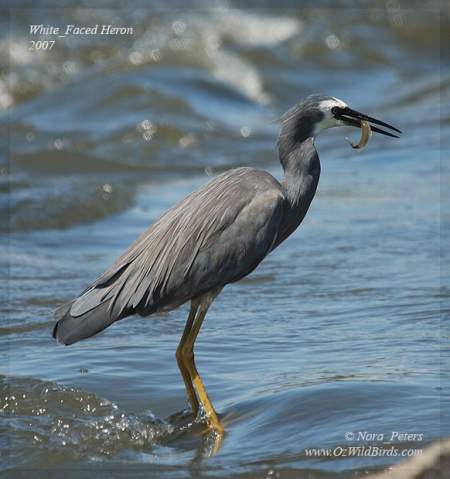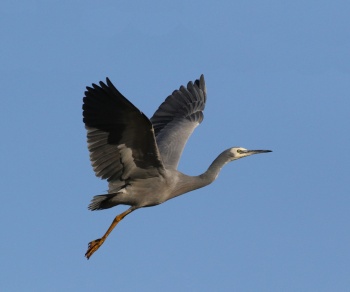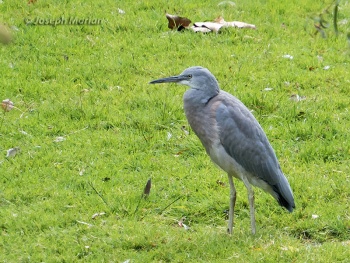- Egretta novaehollandiae
Ardea novaehollandiae
Identification
58–69 cm (22¾-27¼ in); a slender, graceful heron
- Bluish-grey overall plumage
- Yellow legs
- Long, slim neck
- Pointed greyish-black bill
- White face
Breeding birds have long feathers (nuptial plumes) on the head, neck and back. Juveniles lack the adult's distinct white face.
Variations
Northwest Australian birds are darker and separated as E. n. parryi.
Distribution
Breeds in southern New Guinea, New Caledonia, much of Australia except the arid interior, Tasmania and New Zealand where now found throughout North and South Islands and also on some smaller islands. Largely resident but with much wandering and makes regular movements away from on the coast in New Zealand. Vagrants reported in the arid interior of Australia and on many islands including Sulawesi, the Moluccas and Timor, the Kai and Aru Islands off New Guinea, and Lord Howe Island, the Kermadecs, Auckland, Campbell and Macquarie Islands.
Taxonomy
This species is sometimes placed in the genus Ardea.
Subspecies
There are two subspecies[1]:
- E. n. novaehollandiae:
- Indonesia and Australasian region
- E. n. parryi:
- North West Australia
Adams (2013) recognizes the smaller race E. n. nana confined to New Caledonia and the Loyalty Islands[4]. However geographic variation is slight and most authorities consider the species to be monotypic[6].
Habitat
Lakeshores and riverbanks, mangroves, shallow lagoons and on tidal mudflats and estuaries, sometimes rocky shores.
Behaviour
Breeding
The nest is an untidy shallow bowl, constructed from sticks and usually placed on a leafy branch.
Diet
They have a very varied diet, consisting of fish, aquatic insects, amphibians, and in New Zealand they take the introduced Tree Frog.
Vocalisations
Common call is a graak or graaw given in flight, during intraspecific interactions.
References
- Clements, J. F., T. S. Schulenberg, M. J. Iliff, D. Roberson, T. A. Fredericks, B. L. Sullivan, and C. L. Wood. 2018. The eBird/Clements checklist of birds of the world: v2018. Downloaded from http://www.birds.cornell.edu/clementschecklist/download/
- Martínez-Vilalta, A., Motis, A., Kirwan, G.M. & Bonan, A. (2017). White-faced Heron (Egretta novaehollandiae). In: del Hoyo, J., Elliott, A., Sargatal, J., Christie, D.A. & de Juana, E. (eds.). Handbook of the Birds of the World Alive. Lynx Edicions, Barcelona. (retrieved from http://www.hbw.com/node/52691 on 12 February 2017)
- Wikipedia contributors. (2018, August 28). White-faced heron. In Wikipedia, The Free Encyclopedia. Retrieved 22:06, October 30, 2018, from https://en.wikipedia.org/w/index.php?title=White-faced_heron&oldid=856903915
- Adams, R. 2013 [updated 2015]. White-faced heron. In Miskelly, C.M. (ed.) New Zealand Birds Online. http://www.nzbirdsonline.org.nz
- Hancock, J. & J.Kushlan. 1984. The Herons Handbook. Harper & Row, New York.
- Marchant, S. & Higgins, P.J. (editors) 1990. Handbook of Australian, New Zealand & Antarctic Birds. Volume 1, Ratites to Ducks. Melbourne, Oxford University Press.
Recommended Citation
- BirdForum Opus contributors. (2025) White-faced Heron. In: BirdForum, the forum for wild birds and birding. Retrieved 16 May 2025 from https://www.birdforum.net/opus/White-faced_Heron
External Links
GSearch checked for 2020 platform.1






